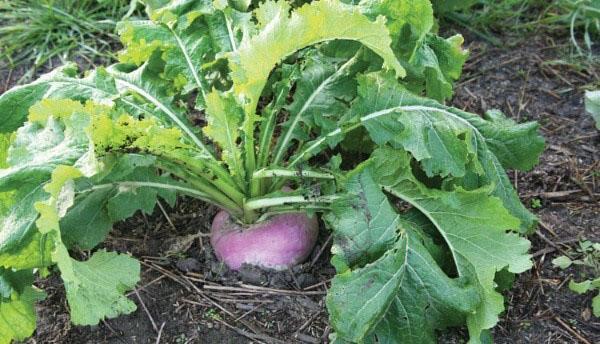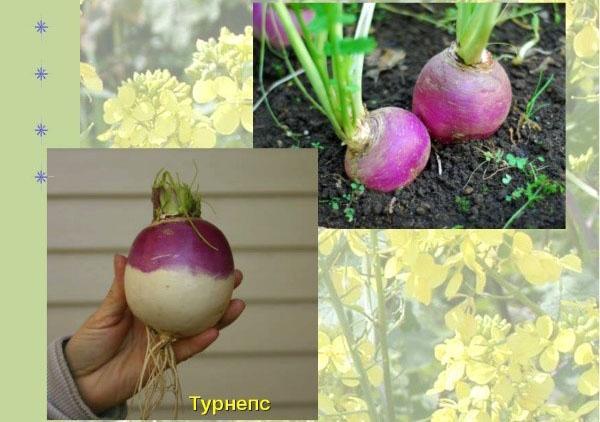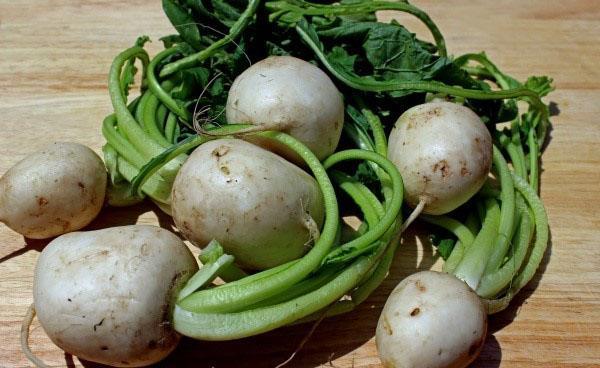Easy cultivation of turnips: sow, take care of a little and harvest on time
 Do you like vegetables and want to diversify your diet? Start growing turnips immediately. The process will not take much time and effort, but the harvest of beautiful and tasty root crops will delight you with its taste.
Do you like vegetables and want to diversify your diet? Start growing turnips immediately. The process will not take much time and effort, but the harvest of beautiful and tasty root crops will delight you with its taste.
Who is this mysterious turnip - briefly about the main thing

The forage types of turnips are distinguished by more powerful, wide, foliage with slight pubescence. Table varieties have smaller leaves, moreover, they are smooth and juicy.
As mentioned, turnip is a biennial plant, although it is often grown as an annual. If the goal is to get only fruits, it is completely removed in the very first season. The fruits themselves are round or elongated and, depending on the variety, can be white, yellowish or purple. There are varieties in which all these colors are present at the same time.
 To collect turnip seeds, it is left to winter in the beds, and the next summer the plants bloom with racemose yellow inflorescences. At the end of flowering, pods with small burgundy-black seeds are formed in their place. It is by them that this culture reproduces.
To collect turnip seeds, it is left to winter in the beds, and the next summer the plants bloom with racemose yellow inflorescences. At the end of flowering, pods with small burgundy-black seeds are formed in their place. It is by them that this culture reproduces.
We select and prepare a place for planting turnips
 In general, planting and caring for turnips in the open field is not a difficult task, because the plant is unpretentious. It is suitable for growing in almost any region and will grow in any soil. However, a really good harvest (especially of forage species) will still be able to be taken on rich and fertile land. Fodder turnips grow best on loams and black soil, as well as in sod and peat soils.
In general, planting and caring for turnips in the open field is not a difficult task, because the plant is unpretentious. It is suitable for growing in almost any region and will grow in any soil. However, a really good harvest (especially of forage species) will still be able to be taken on rich and fertile land. Fodder turnips grow best on loams and black soil, as well as in sod and peat soils.
The area for growing turnips must be prepared in advance, in the fall. It should be dug deeply, adding organic and mineral fertilizers, namely:
- manure (rotted) - 1 bucket per 3 sq. m .;
- nitrophosphate - 1.5 tbsp. for 1 square of area.
Fresh organic matter cannot be used, otherwise the fruits will darken, crack and lose their taste.
Potassium-phosphorus compositions and nitrogen fertilizers should not be added either. The latter can be used a year before sowing turnip, that is, when growing predecessor plants.
 For turnips, a sunny area should be taken away, preferably in a lowland, where moisture remains longer, which he loves very much. At the same time, it is important to avoid places where water stagnates, otherwise the fruits will rot.
For turnips, a sunny area should be taken away, preferably in a lowland, where moisture remains longer, which he loves very much. At the same time, it is important to avoid places where water stagnates, otherwise the fruits will rot.
It is good if in the previous season on the beds planned for growing turnips grew:
- beet;
- grain crops;
- strawberry;
- annual herbs.
After plants from a related family of crucifixes, forage turnips can be planted no earlier than 5 years.
Seed sowing dates
The time when you can sow turnips depends on the method and specific purpose of growing it. Most often, forage turnips are sown:
- In the spring. In open ground, seeds are sown at the end of April, and for seedlings - at the beginning of the month, transplanting them to the garden in May. Such root vegetables can be eaten in the summer.
- In summer. In early July, seeds are planted immediately on the garden bed in order to remove the fruits for winter storage by autumn.
Some gardeners plant seeds before winter, which is also acceptable. So it is possible to harvest a couple of weeks earlier.
Turnip planting methods
When it comes to growing turnips for livestock feed, then most often such plantings occupy a decent area. Unambiguously, in this case, the seeds are sown directly into the open ground. And if you decide to plant a couple of beds of varietal juicy turnips in your garden, you can try to do it by the seedling method. Let's look at both ways.
Sowing seeds in open ground
 Shallow grooves should be made just before sowing. A couple of centimeters is enough, otherwise the seeds will germinate for a long time. Leave at least 40 cm between these beds. Root crops need space to grow in breadth, and it will be more convenient to care for them with a wide aisle. To make small seeds lay more evenly, minimizing thinning, they are mixed with sand before sowing. The sown grooves should be lightly covered with earth.
Shallow grooves should be made just before sowing. A couple of centimeters is enough, otherwise the seeds will germinate for a long time. Leave at least 40 cm between these beds. Root crops need space to grow in breadth, and it will be more convenient to care for them with a wide aisle. To make small seeds lay more evenly, minimizing thinning, they are mixed with sand before sowing. The sown grooves should be lightly covered with earth.
Three kilograms of turnip seeds can be sown on 1 ha of area.
And one more thing - if necessary, the seeds are pre-soaked. This allows them to accelerate their germination, and, accordingly, to bring the harvest time closer.
Sowing turnips for seedlings
 As already mentioned, turnip seedlings are planted in early April. Their germination is good enough and in a couple of weeks sprouts will appear. It is better to sow immediately in separate pots, for example, peat-peat pots - turnips does not tolerate transplanting well. In each pot you need to put a few seeds ("in reserve"), lightly cover them with sand and spray well. As usual, a film is put on top. When the seedlings grow a little, you need to choose the strongest and most developed. The rest - cut off with scissors, without pulling them out, so that one plant remains in each pot.
As already mentioned, turnip seedlings are planted in early April. Their germination is good enough and in a couple of weeks sprouts will appear. It is better to sow immediately in separate pots, for example, peat-peat pots - turnips does not tolerate transplanting well. In each pot you need to put a few seeds ("in reserve"), lightly cover them with sand and spray well. As usual, a film is put on top. When the seedlings grow a little, you need to choose the strongest and most developed. The rest - cut off with scissors, without pulling them out, so that one plant remains in each pot.
Seedlings can be planted on the garden no earlier than the second half of May, when the frosts will leave. To do this, you need to make holes, leaving a distance of 20 cm between them with a row spacing of 50 cm. Seedlings are transplanted one at a time in each hole by transshipment or together with peat pots.
Growing turnips - the basics of caring for beds with forage turnips
 The most difficult thing in caring for a crop is determining the rate of watering. The taste of turnips is influenced by the amount of moisture. If it is in excess, the fruits become watery and lose their taste. Lack and rare watering also negatively affects the harvest, adding bitterness to it. Therefore, it is important to focus on the condition of the soil and take into account the amount of precipitation. On average, you need to water the beds no more than 2 times a week. This is sufficient, unless the summers are dry and hot. Then another watering may be needed.
The most difficult thing in caring for a crop is determining the rate of watering. The taste of turnips is influenced by the amount of moisture. If it is in excess, the fruits become watery and lose their taste. Lack and rare watering also negatively affects the harvest, adding bitterness to it. Therefore, it is important to focus on the condition of the soil and take into account the amount of precipitation. On average, you need to water the beds no more than 2 times a week. This is sufficient, unless the summers are dry and hot. Then another watering may be needed.
Otherwise, taking care of turnips is easy and you will need to carry out a couple more activities:
- Thin the garden bed if the seeds are sown directly into open ground.
- Remove weeds and loosen the soil periodically.
- Feed the plantings twice using organic matter (infusion of chicken droppings or manure). First feeding 3 weeks after planting. Fertilizers are applied for the second time at the beginning of summer, adding superphosphate to the infusion. It will increase the sugar content in fruits, making them more tasty.
The last point is not necessary for fertile soil. There, the culture can grow and give a good harvest without additional fertilizing.
If the turnips are attacked by pests, treatment with garlic infusion or fungicide (Actellic) is needed.With a culture disease with bacteriosis, keel, black leg and mosaic, Quadris or Fundazol will help.
Harvesting
 Whether the roots are ripe is determined by the aerial part of the plant. If the lower leaves begin to fade and dry, it's time to start cleaning. Turnip planted in spring is harvested in June, and sown in summer in September. It is important to catch up to the real frost (minus 6 ° C), otherwise the fruits will freeze, become lethargic and unsuitable for storage. The turnips are stored in the cellar, laid in one layer (preferably on boards). Also, the fruits are well preserved in a trench in the garden, provided that it is covered.
Whether the roots are ripe is determined by the aerial part of the plant. If the lower leaves begin to fade and dry, it's time to start cleaning. Turnip planted in spring is harvested in June, and sown in summer in September. It is important to catch up to the real frost (minus 6 ° C), otherwise the fruits will freeze, become lethargic and unsuitable for storage. The turnips are stored in the cellar, laid in one layer (preferably on boards). Also, the fruits are well preserved in a trench in the garden, provided that it is covered.
Turnip has a high yield: from 1 hectare you can get up to 150 centners of fruits, in particular, fodder varieties.
 Thus, growing and caring for turnips is almost the same as planting turnips or radishes. Having found a suitable place for him and providing the necessary conditions for growth, you can collect a good harvest of juicy root crops. Moreover, you can feast on them not only yourself, but also share with animals from the subsidiary farm.
Thus, growing and caring for turnips is almost the same as planting turnips or radishes. Having found a suitable place for him and providing the necessary conditions for growth, you can collect a good harvest of juicy root crops. Moreover, you can feast on them not only yourself, but also share with animals from the subsidiary farm.